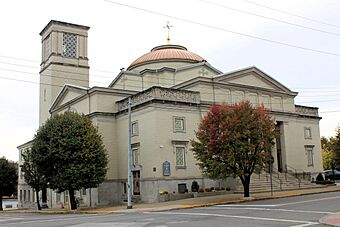Holy Trinity Greek Orthodox Church (Steubenville, Ohio) facts for kids
Quick facts for kids |
|
|
First Methodist Episcopal-Holy Trinity Greek Orthodox Church
|
|

Front and northern side
|
|
| Location | 300 S. Fourth St., Steubenville, Ohio |
|---|---|
| Area | 0.3 acres (0.12 ha) |
| Built | 1914 |
| Architectural style | Neoclassical |
| NRHP reference No. | 06000093 |
| Added to NRHP | March 2, 2006 |
Holy Trinity Greek Orthodox Church is an old and important church building in Steubenville, Ohio, United States. It was first built for a large group of Methodist people in the early 1900s. The current church members, who are Greek Orthodox, bought the building in 1945. This church has a special design called Neoclassical, with a big dome and many columns. It is now known as a historic site.
Contents
History of Holy Trinity Church
Methodist Beginnings in Steubenville
The first Christian preacher in Jefferson County was David Jones, a Baptist minister. He visited in 1772, sharing his faith with Native Americans and early settlers. Methodists arrived in Jefferson County by the 1780s. Their activities in Steubenville began around 1794.
A Methodist group formed quickly, and by 1803, their meeting place was too small. In 1810, some members started a new group nearby. A kind member named Bezaleel Wells gave land for a new church. This church was ready for use by the end of 1811.
Even though many people got sick in 1813, the church grew. Many new members joined during special revival meetings. The new building was finished by 1814, but it needed to be made bigger by 1821. By 1824, it was the largest church in Steubenville.
However, some members left when new preachers arrived. In 1830, the church had 178 members. But 82 members left during a national split that created the Methodist Protestant Church. Also, a sickness called scarlet fever caused many young members to die in 1831.
Despite these challenges, the church slowly became strong again. In 1845, members living in northern Steubenville formed their own church. Eleven years later, the original building was replaced with a larger one. This new building was made even bigger in 1871. By 1910, the church had about 650 members. Because of this growth, the current church building was constructed on the same spot in 1914.
Greek Orthodox Church Takes Over
The first Greek Orthodox people in Steubenville did not have their own church building. Some were part of the Holy Trinity group, which met in the upper floors of shops. Others traveled across the Ohio River to Weirton for church services. This was difficult because both the Fort Steuben Bridge and the Market Street Bridge charged money to cross.
This situation changed in 1945. The Holy Trinity Greek Orthodox group bought the building that used to belong to the First Methodist Church. This gave them a permanent place to worship.
Church Design and Look
Holy Trinity Church is a mix of different Neoclassical styles. Its walls are made of brick with many sandstone parts. The roof is covered with asphalt, and the building sits on a strong stone foundation.
The main entrance is in a special area called a portico. You reach it by walking up a few steps. Four tall Ionic columns stand in front of the entrance, supporting a roof. Above these columns is a tall, flat section called an entablature. A small triangle shape, called a pediment, sits on top of the middle of the entablature.
On the side of the church facing South Street, there is a large section with a pointed roof, called a gable. This section has a big arched window in the middle and smaller rectangular windows. The corners of the building and a section extending along South Street are two stories tall, with a basement that can be seen. Many smaller windows are on all three levels.
A tall square tower, which once had a small dome on top, is located on the South Street side. A much larger dome covers the main part of the church building.
Historic Recognition
In 2006, Holy Trinity Church was added to the National Register of Historic Places. It earned this honor because of its important and beautiful design. It is one of eight places in Steubenville listed on the National Register. Other listed places include the Carnegie library from 1900, the old Steubenville Federal Land Office, and the Steubenville Commercial Historic District downtown.



